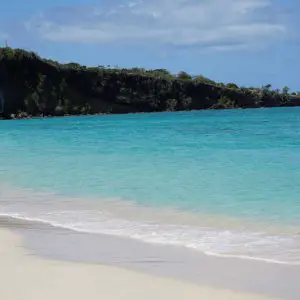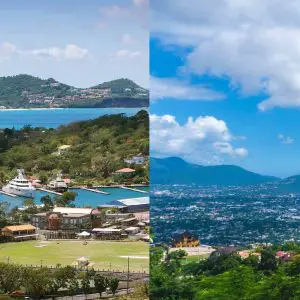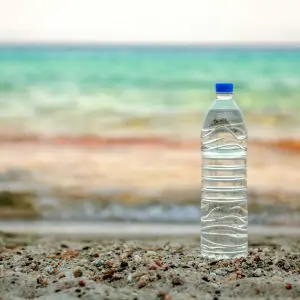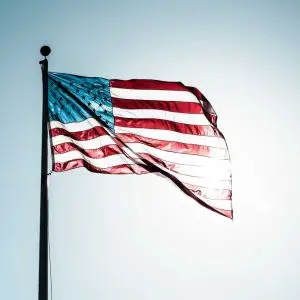It’s January, the middle of winter, and you just want to get out of town somewhere in the Caribbean. But where is the best place to go? Many years ago my family took a vacation to the Mexican Caribbean in January and although the sun was shining and warm enough to wear shorts, it was chilly by the beach. I needed to find a better Caribbean area to vacation in January so dug into the facts and statistics to find a better January vacation spot.
What are the best Caribbean islands to visit in January? The Caribbean Islands with temperatures warm enough to comfortably take a dip in the ocean and partake in water activities are Aruba, Curaçao, and Bonaire often referred to as the ABC Islands. The average temperatures for these islands range from 76 – 86 in January.
When you’re stuck indoors for months on end and forced to endure days and weeks of cloud-cover, just about anyplace with temps above 60° welcome. But when it comes to really getting away to relax, unwind and spend time by the beach or pool in a gorgeous environment, even us northerners like it warmer – a lot warmer.
I spent time researching the islands identifying the average high and low temps and rainfall each month, the hurricane seasons for each and average rainfall.
Next, I determined the minimum temperature the average person (i.e. myself) needs to get down to their swimsuit.

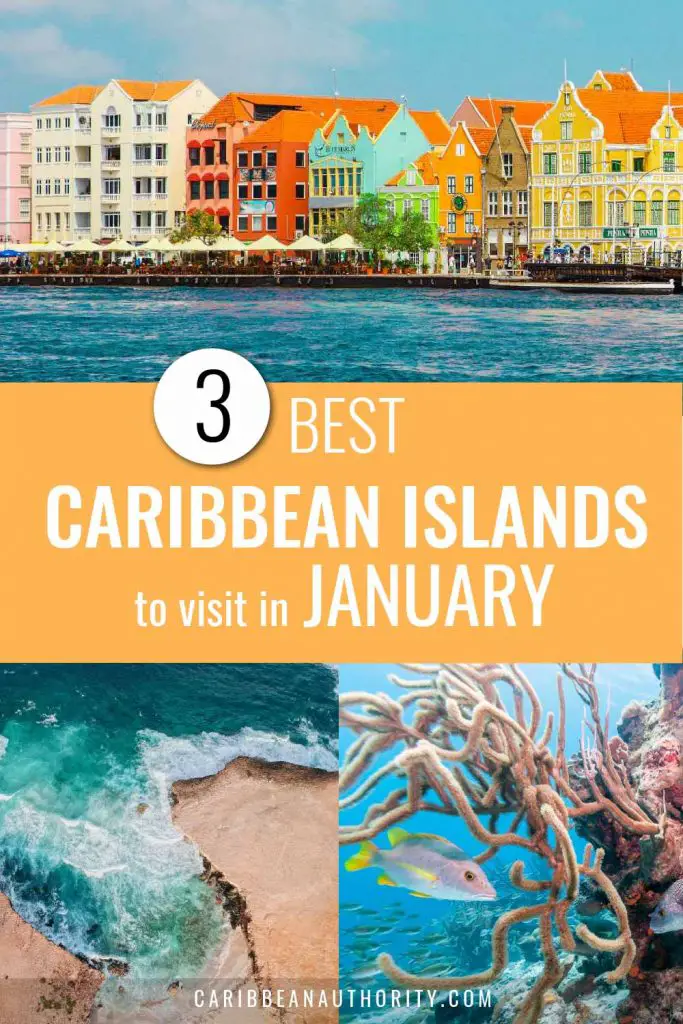
What are the best Caribbean Islands to visit in January?
Presumably, you’re thinking about a trip to the Caribbean for the warm, tropical climate and water options like beaching, hanging at the pool, snorkeling, scuba diving or any other water-oriented activity. That’s great, I wrote this article just for you!
When researching the best Caribbean Islands to visit in January, I defined a simple set of criteria for the best Caribbean destinations to visit in January.
Climate Perfection
- The island’s average low temp for January must be at least 75
- January cannot be hurricane season for the island
- Very low rainfall, if any
Yes, the perfect Caribbean island to visit in January is based on the weather. Simple. That said, the weather isn’t the only redeeming quality of the winning islands. I’ll share more detail shortly.
Without further ado, the 3 best Caribbean islands to visit in January are . . . Aruba, Curacao, and Bonaire – also known as the ABC Islands.
Aruba, Curaçao, and Bonaire – The ABC Islands

The average temperatures for Aruba, Curaçao, and Bonaire in January are 76° – 86° with an average year-round temp of 82°. These islands also enjoy more sunny days than any other Caribbean Islands.
The average rainfall for each island is less than 1″ in January.
The weather on these islands offers the ultimate in comfort. The radiant, consistent sun combined with the constantly blowing north-east trade winds temper the heat making for an amazingly comfortable climate.
All three islands are also outside the hurricane belt! This is awesome if you choose to travel during hurricane season (June – November).
By the way, Grenada (a runners up for January getaways) is also outside the “hurricane belt”. Check out my article How Grenada Became Known as “the Spice Isle’ to learn more about this worthy destination. ]
The 3 islands are located in close proximity to one another and just 90 miles north of Venezuela. Not only are they located close to one another, but the culture and characteristics of the islands are also very similar as well.
All three islands are part of the Kingdom of the Netherlands but in different governing capacities to which different provisions apply.
- Aruba is a “constituent country” of the Kingdom of the Netherlands
- Curaçao is an “autonomous” country within the Kingdom of the Netherlands
- Bonair is a “special municipality” of the Kingdom of the Netherlands
What’s so great about Aruba?
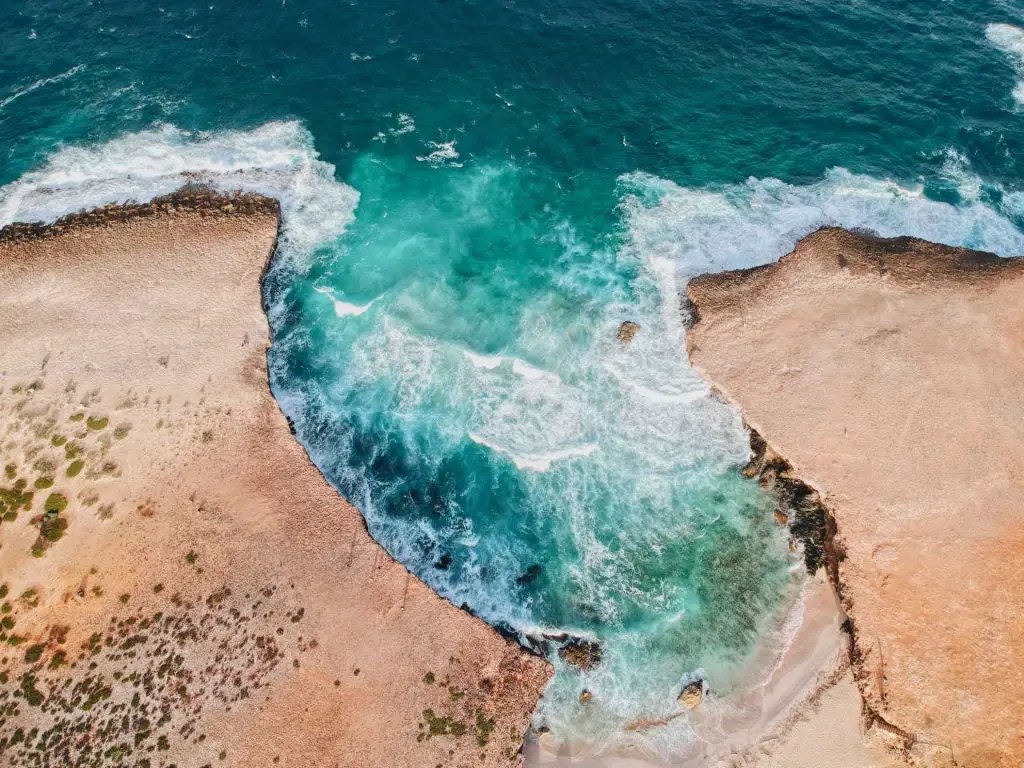
Aruba is a relatively tiny island – only 19.6 miles long and six miles across.
One of the greatest resources on this island is its people. It’s said that the Arubans have a natural sense of hospitality. They even call their home “one happy island”. Who wouldn’t want to go there?
Aruba is very ethnic rich, representing over 90 unique nationalities.
Arubans speak Dutch, Papiamento (a Spanish Creole language with admixtures of Portuguese and Dutch. Most Arubans also speak English & Spanish so no worries about communicating.
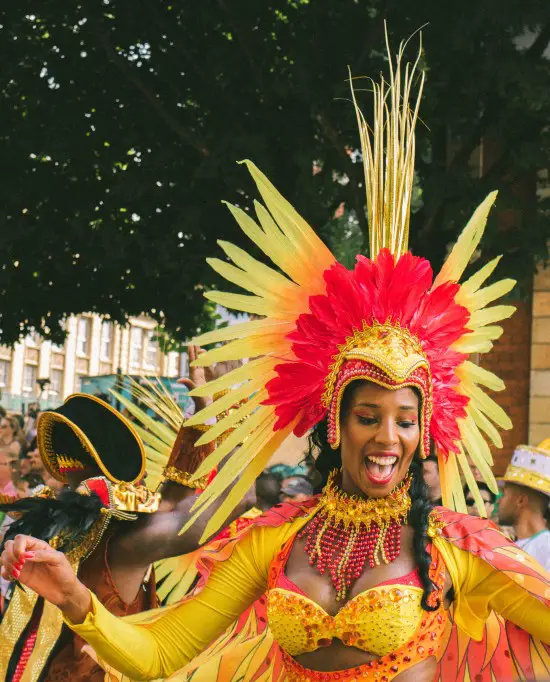
Same as many Caribbean Islands, Aruba is serious about their Carnival celebrations. In case you didn’t know, Carnival is a pre-lenten tradition consisting of elaborately colored parades, masquerades, calypso music, dancing, and lively celebrations. It’s a giant party!
Carnival celebration is a big deal to the islanders and they love to share it with visitors. Some of the celebrations take place in January, most of it in February all leading up to the big parade and burning of King Momo, the day before Ash Wednesday.
No worries about the drinking water on Aruba. Yes, you CAN drink the water! The island creates its own drinking water by desalinating seawater at the local water plant.
Makes you wonder why other countries haven’t caught onto this little trick (i.e. Mexico, Dominican?). Perhaps it’s easier for a small island. Not sure.
Of course, the island has its own prized beaches. The top ones to visit include:
Awesome Beaches in Aruba
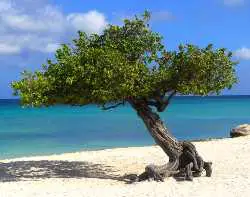
Eagle Beach has been rated one of the best beaches in the world due to its soft white sand and beautiful aquamarine water. It’s located in the island’s capital, Oranjestad. Eagle Beach is home to the most photographed fofoti tree in Aruba.
Baby Beach is in Seroe Colorado, on the southeast end of the island. The waters are so calm it’s safe enough for small children, here the name.
Andicuri Beach is located on the island’s northeast coast, within the Andicuri Bay. This beach’s claim to fame is its breathtaking, scenic setting and the place to go for body-boarding.
Dos Playa, meaning 2 beaches, is located within the Arikok National Park on the southeast part of the island. The beaches are unspoiled, remote and the perfect place, if you’re objective is natural beauty.
Surfers love Dos Playa because of the aggressive waves, but be aware the beaches may be unsuitable for inexperienced swimmers.
Key Travel Information for Aruba
| Airport | Queen Beatrix International Airport |
| Capital | Oranjestad |
| Currency | US Dollar |
| Passport Required | Yes |
| Language | Dutch & Papiamento. Most Arubans also speak English & Spanish |
| Safety | US Travel Advisory Level 1 |
| Timezone | Atlantic Standard Time |
Why visit Curaçao?
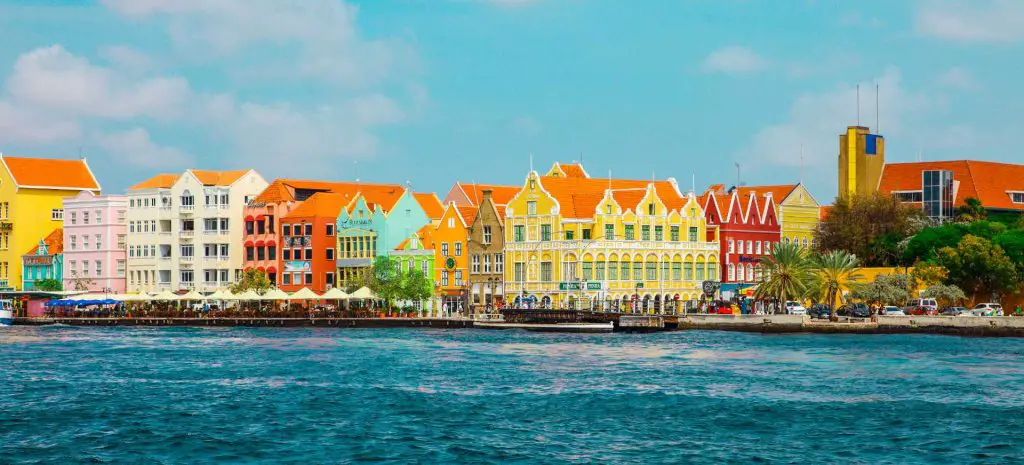
Curaçao is known for its vast number of beautiful beaches tucked into coves and its expansive coral reefs waiting for divers and snorkelers to explore.
You can also drink the water in Curaçao. The island produces its own drinking water via a seawater distillery.
Pastel-colored colonial architecture is prominent in the island’s capital of Willemstad.
A unique, popular site on the island is the Queen Emma Bridge. it’s a floating pontoon pedestrian bridge in Willemstad (also known as Swinging Old Lady) that connects the Punda and Otrobands regions of Willemstad and regularly opens to allow sea vessels to pass.
Awesome Beaches In Curaço
Curaçois home to so many amazing beaches I really had to whittle the list down. I chose the top 5.
Blue Bay is the biggest beach on the island and is located near the village of Sint Michiel just northwest of the island’s capital Willemstad. Blue Bay is known for its diving and snorkeling.
Seaquarium Beach is located in the south part of Willemstad. It was named after the Curaçao Sea Aquarium located nearby. It’s a public beach and host to a variety of bars, clubs, and restaurants.
Playa Kenepa is located on the western side of the island, 50 miles from Willemstad. The beach is small picturesque, in a bay between rocky bluffs.
Jan Thiel Beach is another popular, white sandy beach on the island. It’s popular for water sports as well as the lively restaurant and shopping establishments.
Mambo Beach is the busy trendy beach on Curaço. there are lots of amenities in the area – restaurants, shops and more.
Key Travel Information for Curaço
| Airport | Curaçao International Airport |
| Capital | Willemstad |
| Currency | US Dollar |
| Passport Required | Yes |
| Language | Dutch & Papiamento. Most Arubans also speak English & Spanish |
| Safety | US Travel Advisory Level 1 |
| Timezone | Atlantic Standard Time |
Why visit Bonaire?

Bonaire is another small island in the southern Caribbean. Bonaire is about 23 miles long by about 5 miles wide.
Bonaire is heaven to water sports enthusiasts. Due to its reef-lined coast, snorkeling, and scuba diving are extremely popular. Swimming, sailing, kiteboarding, and windsurfing are other key reasons people visit the island.
Bonaire’s seawater is distilled and purified to become one of the purest drinking waters in the world. How awesome, another island where you can drink the water.
The flamingo is the island’s signature bird. The island is proud to be home to one of the only Flamingo breeding sites in the Southern Caribbean – The Flamingo Reserve.
Fun Fact: Did you know flamingos get their pink color because of a diet rich in alpha and beta carotenoid pigments found in algae and insects?
Awesome Beaches In Bonaire
Bonaire and sister island, Klein Bonaire, are host to over 22 beaches. Some are soft white powdery sand and others are coarser and darker sand due to the reefs and crushed seashells. Here are 5 top picks:
No Name Beach resides on the uninhabited sister island Klein Bonaire so you need to take a water taxi to get there. This island is the epitome of a fantasy beach with its white, gorgeous sand and gently lapping waves. Resting on a coral reef, No Name Beach is ideal for snorkeling.
Chachacha is a popular beach location for families. It’s located near Bonaire’s southern cruise dock. The beach is calm enough for children. I also chose this beach for the name. How fun is “Chachacha”!
Te Amo Beach is a public beach near the airport. The sandy shoreline makes it a breeze to access the water. This too is a popular snorkeling site.
Bachelor’s Beach is a very small beach located at the bottom of a cool 10′ cliff. This is another great site for snorkeling and diving.
Pink Beach is appropriately named given that the beach is home to millions of tiny bright pink sea creatures called foraminifera. The sandy area is rather narrow but still a great spot to soak up the sun.
Key Travel Information for Bonaire
| Airport | Bonair International Airport aka Flamingo International Airport |
| Capital | Kralendijk |
| Currency | US Dollar |
| Passport Required | Yes |
| Language | Dutch & Papiamento. Most Arubans also speak English & Spanish |
| Safety | US Travel Advisory Level 1 |
| Timezone | Atlantic Standard Time |
Bring your Passport
All three islands require a valid US passport book for entry. Make sure you have at least a couple of available pages in your book and that it will not expire at least 6 months prior to departure.
From the US? There are other places to visit that DON”T require a passport. Check out my article Caribbean Islands You Can Visit Without a Passport.
Top Caribbean Destinations to Visit in January Runners Up.
The top three islands to visit in January made the cut by just 2 °. Literally. Two degrees Fahrenheit to be exact.
The truth is there are a lot of other islands that are ideal to visit even in January. We call them the Top Caribbean Destinations to Visit in January Runners Up. Here they are in order of warmest first.
- St. Vincent & The Grenadines
- Saint Lucia
- Barbados
- Saba
- Saint Barthelemy (St. Barths)
- Saint Eustatius
- Sint Maarten (St-Martin / St Maarten)
- Saint Martin (St-Martin / St Maarten)
- Anguilla
- Grenada (Need a reason to visit Grenada? Check out my article 20 Reasons Why Grenada is Totally Worth Visiting)
- US Virgin Islands
- The British Virgin Islands
- Antigua and Barbuda
- Cayman Islands
- Montserrat
- St. Kitts & Nevis
What about Jamaica or the Dominican Republic?
Go for it! Jamaica and the Dominican Republic still have respectable average low temps in January (72°) – they’re just not AS warm as the ABC Islands.
If you want to visit Jamaica, The Dominican Republic or any other Caribbean island in January – Go for it!
Jamaica and the Dominican Republic still have respectable average low temps in January (72°) – they’re just not AS warm as the ABC Islands.
The point is, there’s not really a bad Caribbean destination in January, just better destinations.
Regardless, pick an island and go. You won’t regret it. A bad January day in the Caribbean is still better than a good January day in Wisconsin.
Buy Caribbean Travel Books and Sunscreen on Amazon
Fodor’s Essential Caribbean Full-color Travel Guide
Fodor’s InFocus Aruba Full-color Travel Guide Paperback January 2024
Fodor’s Caribbean Cruise Ports of Call Full-color Travel Guide
SPF15 Broad Spectrum Natural Sunscreen
As an Amazon Associate, we earn from qualifying purchases.




